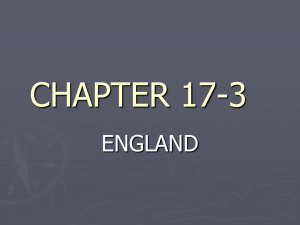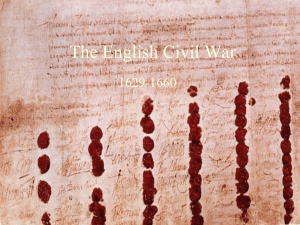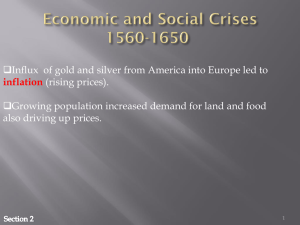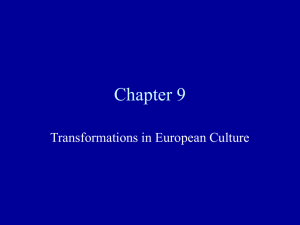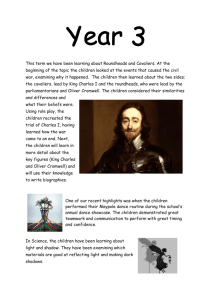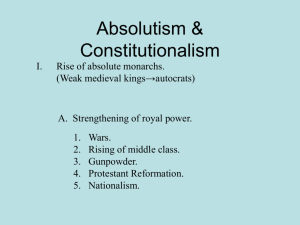The English Civil War
advertisement
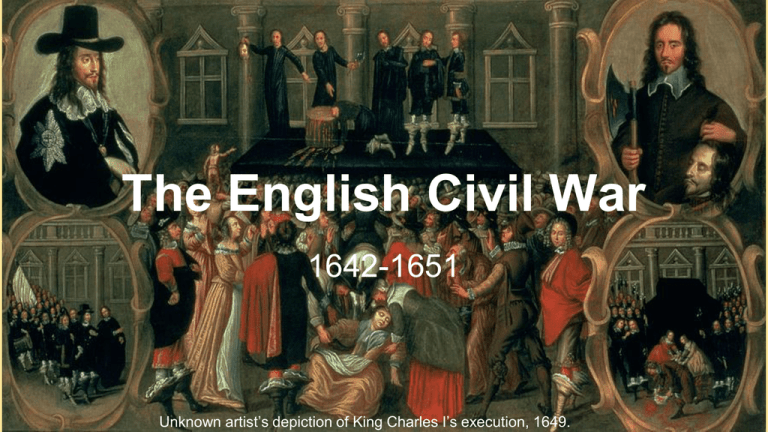
The English Civil War 1642-1651 Unknown artist’s depiction of King Charles I’s execution, 1649. Bell-Ringer What threat exists in the United States of the military taking control of the government, as it has in so many other countries? What means does the United States have to protect itself from a takeover by the military? Origins of the E.C.W. ★ When Charles I came to power, he faced an increasingly aggressive Parliament that resisted new taxes and the king’s efforts to extend his personal control. ★ Charles found ways to do both, including refusing to call Parliament into session between 1629-1640. ★ Religious tensions brought conflicts over his authority to a head. ★ Puritans, Protestants who wanted to purify the Church of England of any Catholic customs, saw Charles as doing the exact opposite. ★ After a Scottish rebellion over these policies, Charles decided to call Parliament into session. Bad idea. ★ Once called into session, reformers in Parliament wanted to undo what they saw as Charles’s tyranny. ★ Some members of Parliament were more moderate in changes and challenges to the king’s power; some were more radical. ★ Both groups’ hands were forced in January of 1642 when Charles and his soldiers invaded Parliament and tried to arrest those who challenged his power. ★ Both sides, Parliament leaders and Charles, ended up organizing armies to square off. ★ Though divided over politics and church government, the Puritans united behind an obscure member of Parliament, Oliver Cromwell, who reorganized the Parliamentary troops to engage Charles’s army. Roundheads & Cavaliers ★ The nickname “roundhead” was given to supporters of Parliament during the war. ★ “Cavaliers” was given to supporters of King Charles. In this woodcutting from the mid-1600s, the Roundheads with their dog “Pudel” are squaring off against the Cavaliers with their dog “Peper.” See the similarities in the haircuts of the dogs and men? The Execution of a King ★ Charles’s forces would eventually be overwhelmed after years of fighting. ★ Charles would end up trying to negotiate with some factions in Parliament, which prompted some to purge those members from Parliament. ★ The leftover members, known as the “Rump Parliament” created a high court to try Charles I. ★ They found him guilty of attempting to establish “an unlimited and tyrannical power” and pronounced a death sentence, which was carried out on January 30, 1649. The Fall-Out ★ After the execution, the “Rump Parliament” abolished the monarchy and House of Lords (upper house of Parliament). ★ They set-up a Puritan republic with Oliver Cromwell as chairman of the Council of States. ★ Cromwell did not tolerate dissent from his policies. He would mount campaigns into Ireland and Scotland to put down dissent, as well as attempts at restoring the monarchy under Charles’s son, Charles II. ★ Eventually, the monarchy was restored after Cromwell died, and while tensions over the power of the king flared up with the Glorious Revolution of 1688, England now has a constitutional monarchy as its government. Death masks were actually a somewhat common practice back then. Afterthought: Cromwell’s Head?! ★ Cromwell died in 1658. ★ When Charles I’s son, Charles II, ascended to the throne he had Cromwell dug up, beheaded, and had the head displayed on a spike for over 20 years! ★ After being lost to a storm and passing down to private collectors/museums, it was reburied in 1960!

